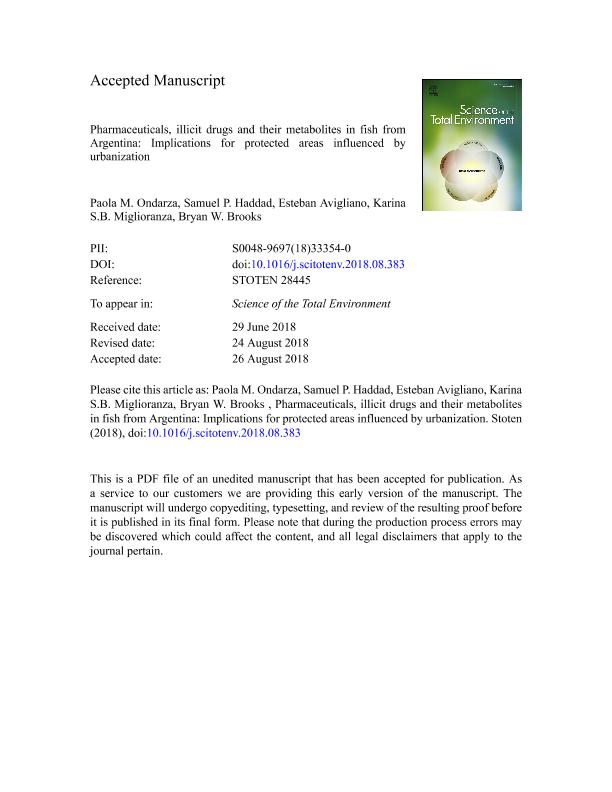Mostrar el registro sencillo del ítem
dc.contributor.author
Ondarza, Paola Mariana

dc.contributor.author
Haddad, Samuel P.
dc.contributor.author
Avigliano, Esteban

dc.contributor.author
Miglioranza, Karina Silvia Beatriz

dc.contributor.author
Brooks, Bryan W.
dc.date.available
2021-11-26T14:17:47Z
dc.date.issued
2019-02-01
dc.identifier.citation
Ondarza, Paola Mariana; Haddad, Samuel P.; Avigliano, Esteban; Miglioranza, Karina Silvia Beatriz; Brooks, Bryan W.; Pharmaceuticals, illicit drugs and their metabolites in fish from Argentina: Implications for protected areas influenced by urbanization; Elsevier; Science of the Total Environment; 649; 1-2-2019; 1029-1037
dc.identifier.issn
0048-9697
dc.identifier.uri
http://hdl.handle.net/11336/147492
dc.description.abstract
Because an understanding of aquatic bioaccumulation of human pharmaceuticals in Latin America is limited, this area was recently identified as a priority environmental quality research need. We examined bioaccumulation of twenty-seven pharmaceuticals, illicit drugs and their metabolites in muscle, liver and gills of multiple fish species (Rhamdia quelen, Hypostomus commersoni, Hoplias lacerdae, Prochilodus lineatus) from an urban river receiving wastewater discharges (Paraná) and a lotic system (Acaraguá) without direct wastewater sources, which runs through a protected area. All samples were analyzed using isotope-dilution liquid chromatography-tandem mass spectrometry. Caffeine, which was detected up to 13 μg/kg, and antibiotics were consistently detected in all fish. Among antibiotics, erythromycin was ubiquitous (0.7–5.6 μg/kg) but its tissue concentrations were lower than levels of sulfamethoxazole, sulfathiazole and trimethoprim (0.9–5.5 μg/kg), which are used in human medicine, aquaculture and livestock. Erythromycin bioaccumulation in fish is reported here from Argentina for the first time, though levels of antibiotics in edible muscles of these species were lower than the maximum residue limits for human consumption. We observed norfluoxetine, the primary active metabolite of the antidepressant fluoxetine, ranging from 1.1–9.1 μg/kg in fish. We further identified benzoylecgonine, a primary metabolite of cocaine, in fish from both study systems, representing the first observation an illicit drug or associated metabolites bioaccumulation in aquatic life from Argentina. Interestingly, high pharmaceutical levels were observed in fish from the Acaraguá river suggesting their transport into the protected area, from the surrounding lands. Though fish from the Paraná river were sampled near WWTP discharges, pharmaceutical concentrations may have been reduced by hydrological and other environmental conditions, and biological differences among species. These findings, which observed bioaccumulation of select pharmaceuticals, their metabolites and illicit drugs in wild fish sampled inside a protected area, highlight the importance of developing an advanced understanding of urban influences on inland protected watersheds.
dc.format
application/pdf
dc.language.iso
eng
dc.publisher
Elsevier

dc.rights
info:eu-repo/semantics/openAccess
dc.rights.uri
https://creativecommons.org/licenses/by-nc-nd/2.5/ar/
dc.subject
ARGENTINA
dc.subject
EMERGENT CONTAMINANTS
dc.subject
FISH
dc.subject
ILLICIT DRUGS
dc.subject
PHARMACEUTICALS
dc.subject
PROTECTED AREAS
dc.subject.classification
Otras Ciencias de la Tierra y relacionadas con el Medio Ambiente

dc.subject.classification
Ciencias de la Tierra y relacionadas con el Medio Ambiente

dc.subject.classification
CIENCIAS NATURALES Y EXACTAS

dc.title
Pharmaceuticals, illicit drugs and their metabolites in fish from Argentina: Implications for protected areas influenced by urbanization
dc.type
info:eu-repo/semantics/article
dc.type
info:ar-repo/semantics/artículo
dc.type
info:eu-repo/semantics/publishedVersion
dc.date.updated
2020-11-18T16:44:39Z
dc.identifier.eissn
1879-1026
dc.journal.volume
649
dc.journal.pagination
1029-1037
dc.journal.pais
Países Bajos

dc.journal.ciudad
Amsterdam
dc.description.fil
Fil: Ondarza, Paola Mariana. Consejo Nacional de Investigaciones Científicas y Técnicas. Centro Científico Tecnológico Conicet - Mar del Plata. Instituto de Investigaciones Marinas y Costeras. Universidad Nacional de Mar del Plata. Facultad de Ciencias Exactas y Naturales. Instituto de Investigaciones Marinas y Costeras; Argentina
dc.description.fil
Fil: Haddad, Samuel P.. Baylor University; Estados Unidos
dc.description.fil
Fil: Avigliano, Esteban. Consejo Nacional de Investigaciones Científicas y Técnicas. Oficina de Coordinación Administrativa Parque Centenario. Unidad Ejecutora de Investigaciones en Producción Animal. Universidad de Buenos Aires. Facultad de Ciencias Veterinarias. Unidad Ejecutora de Investigaciones en Producción Animal; Argentina
dc.description.fil
Fil: Miglioranza, Karina Silvia Beatriz. Consejo Nacional de Investigaciones Científicas y Técnicas. Centro Científico Tecnológico Conicet - Mar del Plata. Instituto de Investigaciones Marinas y Costeras. Universidad Nacional de Mar del Plata. Facultad de Ciencias Exactas y Naturales. Instituto de Investigaciones Marinas y Costeras; Argentina
dc.description.fil
Fil: Brooks, Bryan W.. Baylor University; Estados Unidos
dc.journal.title
Science of the Total Environment

dc.relation.alternativeid
info:eu-repo/semantics/altIdentifier/url/https://linkinghub.elsevier.com/retrieve/pii/S0048969718333540
dc.relation.alternativeid
info:eu-repo/semantics/altIdentifier/doi/https://doi.org/10.1016/j.scitotenv.2018.08.383
Archivos asociados
